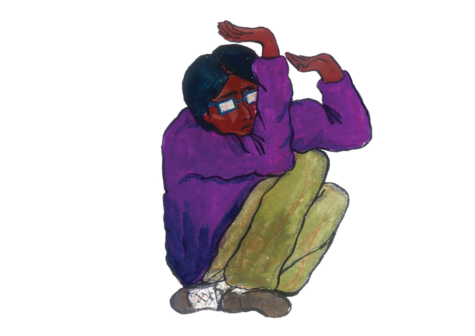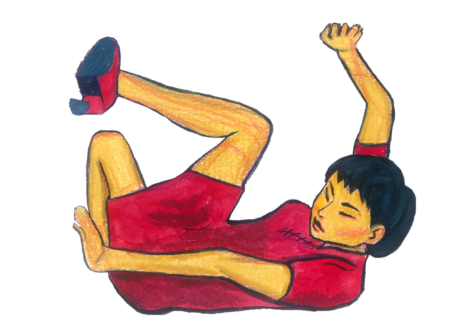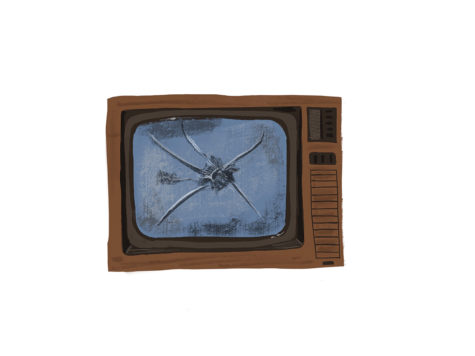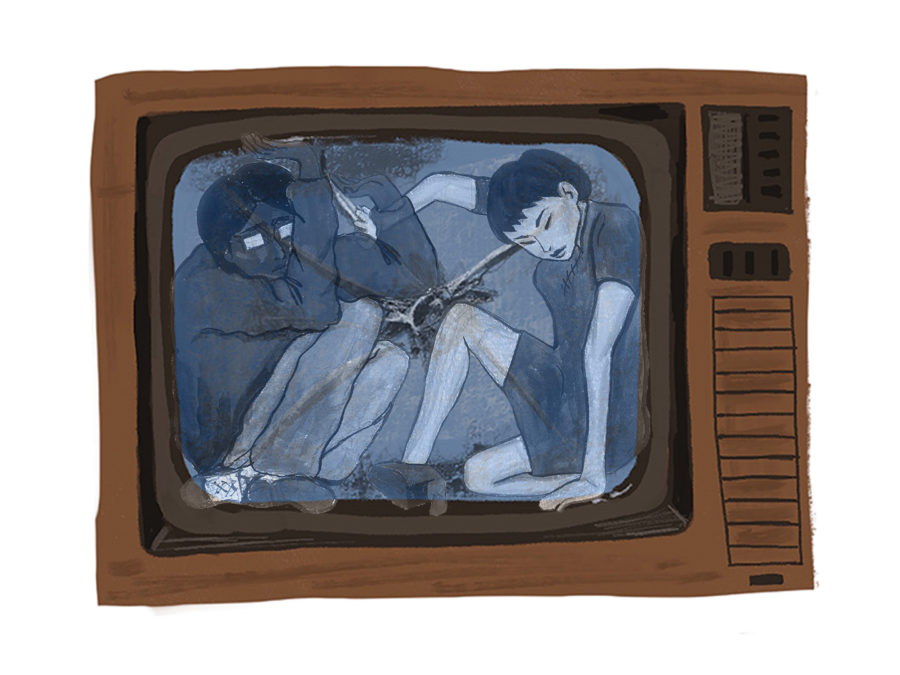Sweeping Oscars, Sweeping Stereotypes
The current ramifications of traditional Hollywood depictions.
Everything Everywhere All At Once has made film history. Telling the story of an immigrant laundromat owner’s multiverse adventure, the film’s wacky and chaotic nature explores a variety of themes, touching on nihilism, love, and the immigrant experience in America. Since its release, the movie has received over 150 accolades from major critic associations and filmmaker organizations—including the Academy Awards, where they took home a historic seven Oscars.
As the first Asian woman to win in the Best Actress category, Michelle Yeoh began her acceptance speech by dedicating the award to Asian youth, exclaiming that it was a “beacon of hope and possibilities.”
Ke Huy Quan—the first Vietnamese-American to win the Best Supporting Actor award—used the speech to detail the arduous journey it had taken him to get where he is, explaining: “My journey started on a boat. I spent a year in a refugee camp, and somehow I ended up here, on Hollywood’s biggest stage!”
Joyous and grateful, their Academy Award acceptance speeches serve as a closing to what has been a triumphant award season for the movie. Starring a predominantly Asian cast, Everything Everywhere All At Once writes multi-faceted characters, stripping them of common Asian stereotypes and instead choosing to focus on telling a captivating story. The film’s success—as both a box office hit and a critically acclaimed film—serves as a significant breakthrough for Asian-led movies, with characters that have made consumers feel represented. But it hasn’t always been this way in Hollywood. When looking back, there has been a history of Asian characters on-screen having been plagued with stereotypes.
The Dearth
“I barely ever see someone that looks like me on TV,” said Indonesian-American sophomore Abigail A. A study conducted from 2007 to 2019 by the University of Southern California found that Asian and Pacific Islander (API) characters only amounted to 6% of speaking roles in the highest-grossing movies. Of this small percentage, API leads were present in just 44 films—out of 1300 in total.

As stated by sophomore Keya K., “If you’re a kid, and you never see yourself portrayed on screen, it’s a bit hard to grow up.” To see positive and accurate representation in the media means the potential to break down boundaries, evoke feelings of curiosity, and ultimately create influential role models for the wider audience.
Commonly Found Stereotypes
When asking the JIS community what they most commonly saw in mainstream characters of their own race, many described “typical nerds,” “bad at English,” “overtly spiritual,” and “exotic” as the most frequent. Upon questioning whether or not these stereotypes were harmful, the majority strongly agreed.
With the films and TV shows consumed on a daily basis becoming an influential source for thoughts, instances when many in a racial group feel they are not being accurately represented end up becoming a cause of concern. The Asian characters that are displayed on-screen may not translate how an audience member believes they are as a person. And in cases where widely-used stereotypes become written into characters, these can potentially cause unknowing bias and preconceived notions to form in non-Asian consumers, creating issues that move off-screen.
Model Minority
Diligent. Law-abiding. Brainy. Of the small percentage of Asian characters in Western movies, many perpetuate a stereotype labeled the “Model Minority.” The term, having been coined by sociologist William Petersen in his 1966 article titled “Success Story, Japanese-American Style,” was used to describe the triumphs that Japanese Americans were able to achieve post-World War II.
With racial groups being compared to one another, the coveted spot—the Model Minority—is given to those who represent exemplars within the typical American society. Petersen describes this as being economically abundant, people who have “risen above… prejudiced criticism,” and treated their education like a “military campaign against the hostile world.” As time has passed, this has stretched to become synonymous with the rest of the Asian race and a particular stereotype that still has an impact on members of society to this day.
Traces of the “Model Minority” can be found to be included in many of the Asian characters who are seen in Western cinema, commonly in the form of the typical academically-achieving nerds, musical prodigies, and strict and overbearing “tiger moms” that appear on-screen. But in hindsight, what may be perceived to be a positive way to think of the Asian population is one that can be very harmful, instead.
If a widely-consumed movie or TV show promulgates this particular idea, expectations to align with the stereotype can be formed within both Asians and non-Asians alike.

As explained by sophomore Abigail A., “It can be extremely harmful, especially for younger kids who are Asian and who look up to these movies and [aren’t] academically excelling.” In turn, doubts may form, and the creation of correlations between race and academic achievement may be established by those watching.
As noted by freshman Inho Y., “In Korea, the education system is really difficult… but for [students] who [live abroad], [people] kind of expect you to be at the same level.”
The “Model Minority” stereotype expects Asians to be proficient in a variety of subjects, retain more economic wealth than the population average, and remain role models for society, creating a source of pressure for some. And perhaps as a large fallacy: this idea leaves very little room for failure—something that is inevitable.
Without missteps and mistakes, opportunities to learn and evolve become limited—and as an important part of everyday life, growth is necessary.
The Exotic Woman
The hypersexualization of Asian women in film has created various harmful tropes made only to degrade. Of all the temptresses, dragon ladies, and lotus blossom-esque characters, this viewpoint deduces Asian women into submissive and seductive roles that objectify them. As the least harmful of ramifications, real-life assumptions are being made of Asian females that are formed as a result of exposure to the “Exotic Woman” stereotype—and as the most harmful, people acting on these assumptions.
In Atlanta, powered with a motive that spas were “temptations” that “needed to be eliminated,” a white gunman opened fire in three separate locations. As a result, six Asian women were killed on March 16, 2021.
The particular stereotype that these events occur under can be traced back to the Western movies that have been created. Take the movie Madame Butterfly, where an Asian protagonist—portrayed as a meek and “exotic woman”—falls in love and marries a white man. Upon the end of the marriage, she commits suicide due to him leaving her.
The juxtaposition of the tough and All-American male with the “obeying” foreign female can become a relationship sought out, ultimately fetishizing the Asian race and prioritizing that on top of any real human qualities.
“It makes me really mad because we are so much more than that,” said Abigail A. “We are so much more than our bodies and more than our looks.” Furthermore, two freshmen expressed that they felt “uncomfortable” and “annoyed” that “women are shown as weaker.”
Albeit this, it is key to point out that this is not something that every single Asian woman on-screen has been deduced to. Still, as a sizable power, Hollywood’s enablement of said tropes has created a rippling effect outside the screen, affecting the lives of innocent individuals. When security and entire livelihoods are on the line, this issue amounts to something bigger than any token love interest added to the plot.

Modern Day Breakthroughs
The issue of more accurate Asian representation has become more prominent, discussed by moviegoers and industry members alike. With the rise of recent Asian-led cinema, previously overlooked talent is now being recognized, and so is the potential for a much more inclusive future. Evidently, excitement among the Asian community in JIS is present, with eager reactions being shared.
After winning the Best Original Song Oscar, RRR has made history as the first Indian production to ever do so in the category: “Seeing the West like an Indian movie is like—holy [expletive]—it’s amazing!”
Another major trailblazer—and the first Asian-led ensemble in a Hollywood production this century—Crazy Rich Asians gained worldwide attention for its inclusivity. “That movie I love the most, just because there are people in the movie that look like me,” said sophomore Abigail A.
The biggest film franchise to date, the Marvel Cinematic Universe has now added the Ms. Marvel miniseries starring a Pakistani-American as its lead. Receiving major traction, it’s been mentioned on two separate occasions when conducting interviews for this article. According to Keya K., “They showed the whole culture and background of this person without turning her into a stereotypical South Asian.” Agreed upon by a senior when discussing a specific sequence in the show: “That was amazing, hearing all those [cultural] songs in a Marvel project. That was cool.”
The joy from these reactions proves the importance of accurate and positive representation for many among the Asian audience. With change, there is undoubtedly more progress still to be made—so, what do the Asian members of the JIS community hope for the future?
The night of the 2023 Academy Awards contained many triumphs for Everything Everywhere All At Once. But perhaps the largest victory was the road that it paved for Asian representation in Hollywood—proving that box office success and critical acclaim can still happen when valuing authenticity over stereotypes.
